Do you buy postcards or do you prefer to capture your own images while enjoying the Thousand Islands?
Like most people today, you likely have a dedicated camera or one contained within an electronic device, such as a phone or tablet. These sophisticated devices let you easily capture memories. However, if you want to produce photographs and not simply take pictures, you need to take control of your camera and pay attention to your environment.
I recently opened a new studio in the Thousand Islands and am currently specializing in marine photography. I enjoy the entire process as a photographer: from the concept and planning of an image, to the capture, post production and finally the presentation, either by a fine art print or audio-visual production.
Water can help make beautiful images or it can greatly detract from a shot. Let me briefly touch on 10 points that will enhance your images when photographing this beautiful region.
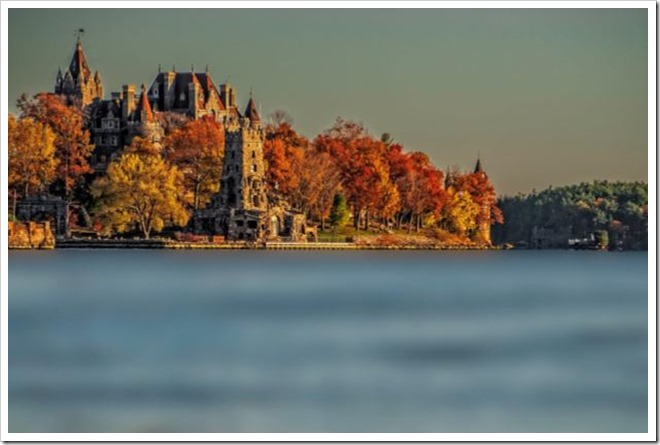
Pre-dawn light provides softness to the image and eliminates all distractions of tourists on the island and
boat traffic on the water. Polarizer to enhance the foliage. Digitally soften and tint the water to bring
attention to the castle.
|
1) Be there!
If you want a great picture you need to plan on getting the best viewpoint and perspective. You physically have to get into position and be among the islands that may involve a boat. Tour boats are great, but they do not allow you to approach a subject, move around and then pause for the shot. The islands are a dangerous place to navigate, littered with rocky shoals. Consider a shallow draft boat such as a jet boat or kayak. Don’t wait for a sunny day but get out there as the weather patterns change for interesting skies.
2) Pay attention to the light
Photography is all about capturing light. Observe how different light affects the water. Bright sunny days usually provide better colour in the water, but also result in deep shadows and high contrast within the scene. Backlight is the toughest to work with, the reward being the most dramatic images. Any photographer will tell you the best light is a half hour before and after sunrise and sunset. You may have to get up at five in the morning, though you will be rewarded by a world like no other, particularly in the fall.
3) Use a lens hood
Unwanted glare can ruin a photograph. Don’t try and claim it is artistic, when the glare simply washes away your image. If your camera will accommodate a lens hood, then keep it on. If you do not have one, use your hand or a brochure over the lens to help shield extraneous light. You will be amazed at the difference this simple device can make to your images. Secondly, a hood also serves to protect your lens, should it get banged while moving about a boat.
4) Use a polarizer filter
A polarizer filter attached to your lens will help reduce reflection on the water surface and surrounding objects, such as boat hulls. The filter can be rotated to adjust the effectiveness. The polarizer can help add a deeper colour to the water and allow you to see the rock beneath the surface, when along the shoreline. I used to carry over 30 glass filters before the digital age. Today, the polarizer is the one filter I still have with me at all times. The filter is most effective at right angles to the sun or light source. The difference in an image can be stunning when applied properly.
5) Shoot RAW files
If your camera has a RAW setting, then move to it. For example, Nikon users have the NEF file format. Today when you take a picture, you are going to do some post processing or digital editing. Yes, you are! That point is non-negotiable. The goal when taking the picture is not to have a final image in the camera, but to capture as much data as possible so it is available to you when you do process the image in the computer. JPEG is a compressed format that throws away data. A JPEG is fine for snapshots but we are starting to create photographs. Would you bake a cake and throw away half the ingredients before you started?
6) Take control of your camera
Don’t be a slave to technology; take charge. Manage the settings in the camera that are important for the shot you are trying to achieve. If you want a sharp picture of high performance boats in a poker run, then you need to set the highest available shutter speed. If you are trying to create the milky effect of water in motion, close the aperture to drag the shutter for a second or two. The best image quality is obtained by setting the ISO of the camera to its lowest possible value. Learn to read a histogram if you have one in your camera and ensure the data is not clipping at either end of the exposure scale.
7) Include only what you want the viewer to see in the image
Focus on your subject; then let your eye move around the viewfinder and along the edges. Move in, or zoom to eliminate what is not contributing to your image. Change your position or perspective to isolate or frame your subject. It is human nature to look at only the subject when we take the picture. Later, someone viewing the photo will see everything else that is in the image.
8) Ensure the subject is sharp
It is impossible to recover an un-sharp, or out of focus image. What may look sharp on a 2” screen can quickly fall apart on a large screen or photographic print. On land I nearly always use a tripod. Water is not a stable platform and in a boat I must adapt to the wave action. In rough water I may be able to keep the boat more stable by moving ahead at slow speed with the drives dug into the water. If stationary, there is less bounce with the stern taking the waves rather than the bow. Shoot when you are in the wave trough and not riding the crest. Physically place yourself as close to the centre of gravity of the boat as possible, to limit your movement. Increase your shutter speed and perhaps bump-up the ISO in rough water.
9) Edit ruthlessly
Learn to delete. Review your images and select only the ones you intend to process and share. People, even your friends, only want to see your best shots and not twenty images of the same subject. Quality not quantity is what we are striving for. You will quickly forget your throw-a-ways if you concentrate on your best shots.
10) Post processing
You need photo editing software. It can be a simple suite or full blown Photoshop, with a myriad of plug-ins and supporting programs. Every image needs to be processed. On the water I will guarantee each image needs to have some highlight reduction and shadow recovery. If you shot in RAW format, this is where your image comes alive. Today most editing suites offer easy slide controls for basic adjustments; this simply becomes part of your work flow. If you didn’t get it right on the water, don’t be afraid to crop now. The reality today is we spend less time with the camera and more time in the digital darkroom. If you want to get creative, beyond the basic adjustments, this is where you work your magic with all that captured data.
The following are a few examples incorporating some of the techniques I have spoken about:
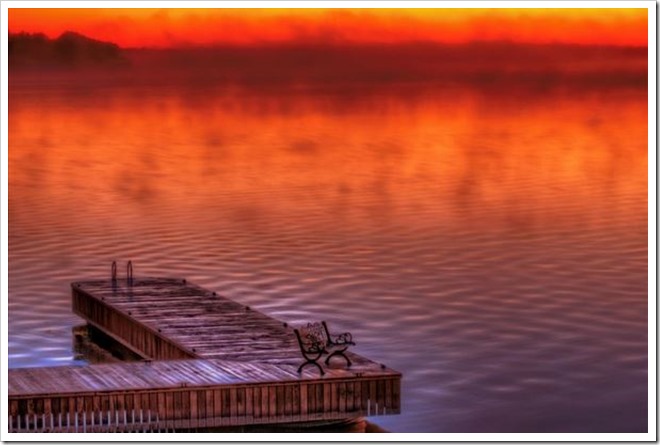
First light to capture the warmth and backlight to highlight the mist. High vantage point to
eliminate distraction and show more of the dock. Lens hood to guard against flare.
|
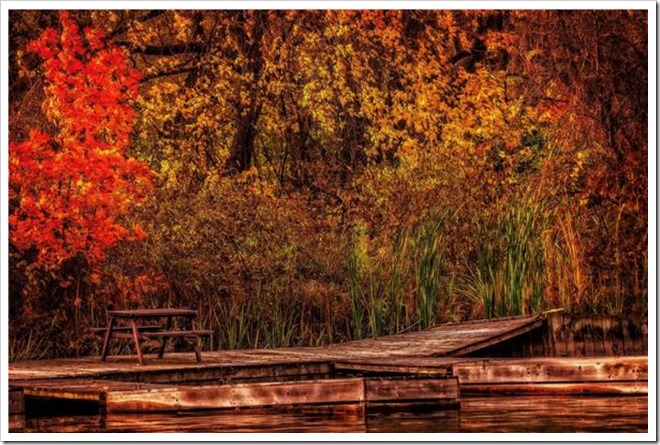
Simple subject. Selective background. Polarizer to remove glare on leaves and water.
|
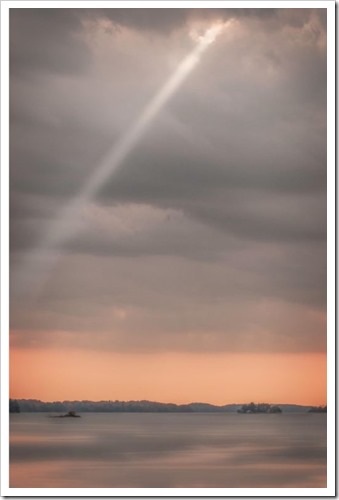
Changing weather pattern to capture light rays. Diffuse water in post processing to
remove harshness and soften the scene.
|
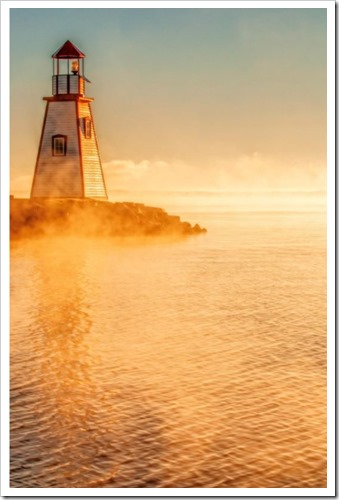
Isolate subject to remove distractions such as signage and garbage cans. Strong
backlight at sunrise. Lens hood to control flare. Note: polarizers are not effective
against backlight and can add lens flare.
|
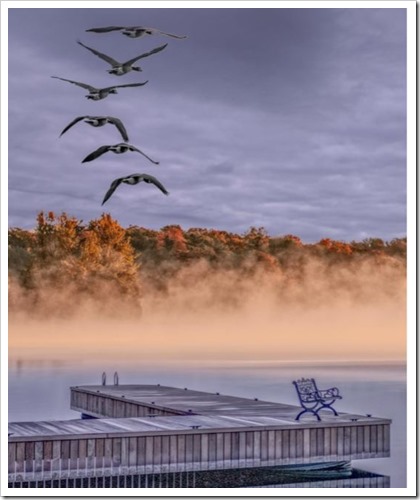
What the Thousand Islands are to me: Water, sky, islands, wildlife and tranquility
Three simple subjects blended together in post processing to illustrate that theme.
|
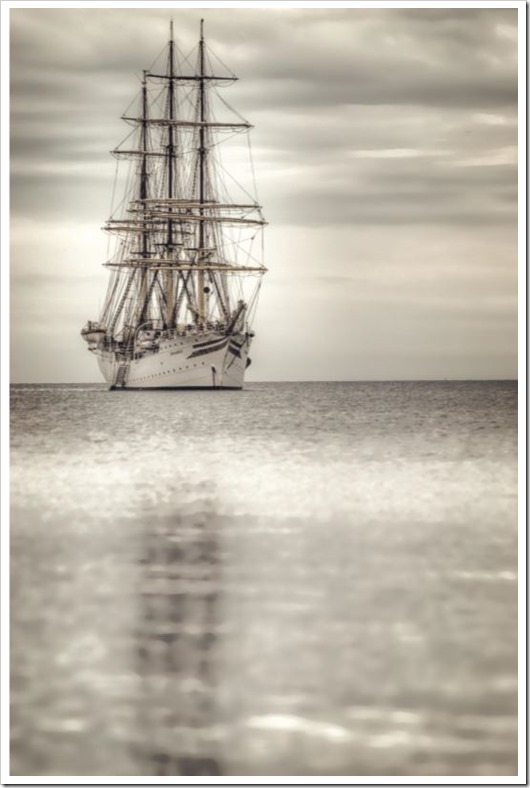
Planning (Researched and followed ship on GPS to locate and find her in open water)
Backlight for glow and desaturation in post processing to set a historical mood.
|
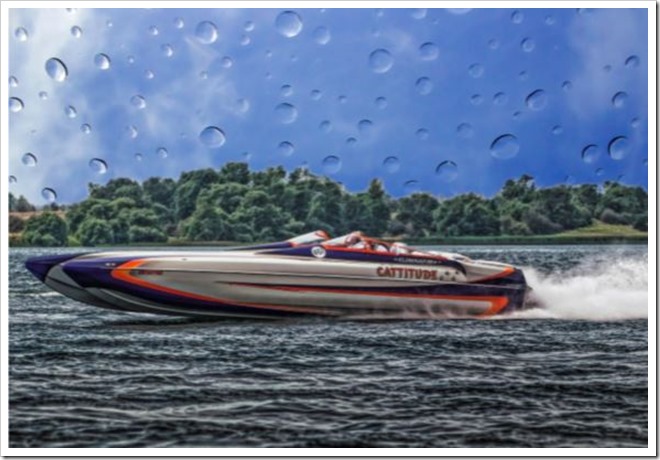
Select a backdrop first, then wait for the subject to pass. High shutter speed to freeze action.
Lens hood and polarizer. Post processing to slightly digitize backdrop and add water droplets.
|
Obviously I am just touching the surface when it comes to photographic techniques. However, simply following one or more of these tips will begin the movement towards becoming a better photographer.
See you on the water.
By Paul Holland, Presentation Photo
Paul Holland is a relatively new fine art photographer to the Thousand Islands. He developed his love for photography while studying architecture at Carleton University. Somehow that led to a career in policing, although he was still able to run an AV Production company that served the corporate and government sectors. Paul and his wife now live in Gananoque. You can view more of this unique work at www.presentationphoto.com.